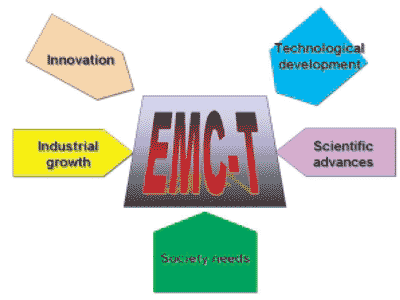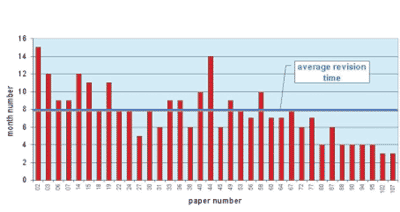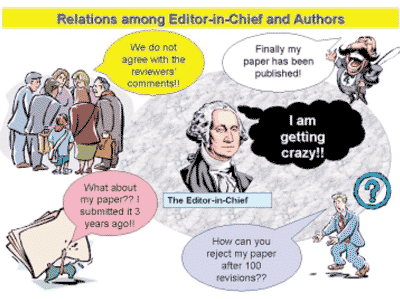Editor’s Note: This article contains highlights from the special session held during the Montréal EMC Symposium. The session addressed the Transactions on EMC, IEEE Xplore, as well as the EMC Society Newsletter. Marcello D’Amore, Editor-in-Chief of the Transactions on EMC, organized this special session which drew a standing room only crowd. |
The Editorial Board
The Editorial Board consists of the Editor-in-Chief, the Managing Editor, three members of the Advisory Board (AB) and eighteen Associate Editors representing nine different countries. The AB members express their opinion about the scientific level and the developed topics of the Transactions and address any criticism received. The AB members may be involved in the review process in some cases, for instance when the final decision concerning the acceptance of a paper is very uncertain. The previous number of 52 Associate Editors has been sensibly reduced in order to guarantee a paper review process at a high technical-scientific level, homogeneity of the evaluation criteria, and efficiency. For the overall management of the Transactions, the Editor-in-Chief counts on close collaboration with Flavio Canavero, Managing Editor, and on the experience and suggestions of Len Carlson, EMC Society Vice-President for Communication Services.
Technical-Scientific Contents
The technical-scientific contents of the Transactions are inspired to the main objectives of the EMC Society: “The IEEE EMC Society strives for the enhancement of electromagnetic compatibility through the generation of engineering standards, measurement techniques and test procedures, measuring instruments, equipment and systems characteristics, improved techniques and components, education in EMC and studies of the origins of interference.”
The Transactions is an appropriate medium through which the IEEE members may benefit from the activity of the EMC community in the world; a “paper” is the proper vehicle for the presentation of thorough EMC engineering work of archival (long-lasting) value, including both advances in the state of the art, theoretical and experimental, and tutorial information.
The topics focus primarily on the electromagnetic fields, the circuits and the measurements; the methodologies can be analytical, numerical, and experimental; the applications concern numerous different industrial sectors. Such aspects highlight the characteristics of the high inter-disciplinary of Electro-magnetic Compatibility, which is a science difficult to teach and to learn, on the boundary with other fields. As a consequence, the scientific investigation is stimulating because it can count on a wide range of methodologies, it can recognize problems and solutions that are common to several sectors, and it can become a synthesis of qualifying experiences. Nevertheless, the same characteristic of inter-disciplinary can represent a negative aspect, such as when the considered topics are of prevalent interest to other sectors than EMC, or lack original EMC contents.
Fig.1 shows the topic statistics of the papers published in the Transactions in 1998, 1999 and 2000. The worldwide paper distribution in the same three years is represented in Fig.2 for the IEEE Regions. It is appropriate to promote actions in order to encourage authors to submit papers from countries from which very few papers have been submitted in the past.
Main Goals of the Management
The main scope of the management is the preservation of the EMC content and the attention towards topics of interest to the EMC community that are in strong evolution or not strongly represented in the Transactions on EMC. For instance, Electronic Interconnects and Packaging, High Power EM Fields, Intentional EMI, Information Security, Innovative Materials, and Wireless Systems, Transport Systems and Aerospace, for which the EMC environment is suggested by Fig.3.
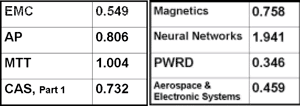
Table 1. Journal Impact Factors of some IEEE Transactions.
A very important objective is the definition of the current/future scientific/ technical trends in order to maintain the high level of the Transactions, and to increase its competitiveness with respect to other Journals, which represent higher values of Impact Factor (IF), according to Table I. It should be pointed out that the number of the submitted papers per year is low compared to other IEEE Societies, such as MTT, AP, PES, and CAS. Information activities should be developed in order to involve experts in the EMC fields that are poorly represented in the Transactions on EMC. In synthesis, the elements on which the development of the Transaction should be founded are described in Fig.4.
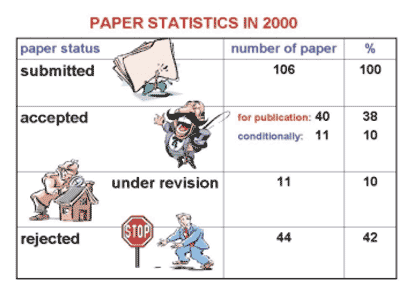
Table II. Review status of the papers submitted in 2000 (July 31, 2001)
It is also very important to achieve a substantial reduction in the time that elapses between submission of a manuscript and its publication. Fig. 5 shows the revision time of papers accepted for publication in 2000. The review status of the papers submitted in 2000 is represented in Table II (July 31, 2001). The revision time depends on the following factors: the choice of the reviewers, the time required by each reviewer to complete the first revision, the eventual request of mandatory changes, the time needed by the authors to make the required corrections and changes, and the time needed by the second revision. Such a procedure, which is applied in most cases, allows one to improve the technical and scientific level of the submitted manuscripts. However, the Associate Editors and the reviewers should avoid excessively detailed changes, i.e. they should not act as “co-authors.” In other words, it is necessary to find a compromise between the changes requested and a short revision time. Much of the review process time can be justified only by scientific reasons concerning the contents of the submitted manuscript, but not by the indolence or poor availability of the reviewers. Each reviewer should require no more than one month for a paper (actually three weeks are requested, but this is generally not respected). The review process should be completed within three months.
The problems concerning the relations between the Editor-in-Chief and the Associate Editor, between the Associate Editor and the reviewers and between the Editor-in-Chief and the authors are described in Fig. 6. The management foresees the publication of Special Issues concerning themes of broad interest in the world. However, the Transaction budget is limited to 600 published pages each year. Such a page count allows the publication of four regular issues per year, and makes the publication of Special Issues difficult. Nevertheless, the Special Issue on “Recent Advances in EMC of Printed Circuit Boards,” prepared by Guest Editor Flavio Canavero, will be published in November 2001. Moreover, the Special Issue “In Memory of Motohisa Kanda,” with Guest Editors Chris Holloway and Perry Wilson, is scheduled for publication in February 2002. Finally, the new Special Issue “Advanced EMC Numerical Modeling” with Guest Editors Christos Christopoulos and James Drewniak is planned for February 2003 (deadline to submit full papers is May 15, 2002).
The Electronic Paper Submission and Review Process
In 1998, one of the IEEE strategies for the future established a goal to “reduce the time from submission to delivery of a peer-reviewed article dramatically while maintaining or improving quality.” As a consequence of this assignment, the IEEE Publication Activities Board, after a survey of the peer-review process at different journals, developed a plan that led to the Manuscript Central project that enables the entire peer-review process to take place completely online. Since last September, the electronic paper submission and review has been activated for the Transactions on EMC by using the Manuscript Central system.
Authors are invited to submit their manuscript electronically on the web to https://temc-ieee.manuscriptcentral.com. From this entry page, access can be obtained to all information required for the submission of a manuscript. It should be noted that manuscripts must be submitted either as a PDF document or as a Postscript document.
 Marcello D’Amore has been full
professor of Electrical Engineering since 1980 at the University of Rome “La
Sapienza.” He was head of the Electrical Engineering Department from 1983 to 1985 and
from 1989 to 1995, and President of the National Group “Electrotechnics” from
1984 to 1990. He has published more than 100 papers in the field of power systems and
electromagnetic compatibility. Current research interests include lightning interaction
with aircraft, radiated susceptibility and emission of complex networks, and shielding. He
was the central coordinator of an EMC Project supported by the European Communities in
Science Plan in 1994, and Chairman of the National Committee “Human-exposure to high
frequency EM fields” of CEI from 1991 to May 2001. He was Guest Editor of the 1996
Special Issue of the IEEE Transactions on EMC addressing “EMC Research in Italy”
and Guest Co-Editor of the 1998 Special Issue addressing “Lightning” of the IEEE
Transactions on EMC, and was Chairman of the International Symposia EMC ROMA ’94,
’96, and ’98. He is Chairman of the EMC National Group of AEI, Director of
CIRCE-EMC Research Network, Chairman of ISC of the International Symposium EMC EUROPE
2002, and Editor-in-Chief of the IEEE Transactions on EMC. Professor D’Amore received
the Best Paper Award of the 1993, 1997 and 2001 IEEE International Symposia on EMC as well
as the ISH ’97 award in Montréal. He has been a Fellow of the IEEE since 1990. EMC
Marcello D’Amore has been full
professor of Electrical Engineering since 1980 at the University of Rome “La
Sapienza.” He was head of the Electrical Engineering Department from 1983 to 1985 and
from 1989 to 1995, and President of the National Group “Electrotechnics” from
1984 to 1990. He has published more than 100 papers in the field of power systems and
electromagnetic compatibility. Current research interests include lightning interaction
with aircraft, radiated susceptibility and emission of complex networks, and shielding. He
was the central coordinator of an EMC Project supported by the European Communities in
Science Plan in 1994, and Chairman of the National Committee “Human-exposure to high
frequency EM fields” of CEI from 1991 to May 2001. He was Guest Editor of the 1996
Special Issue of the IEEE Transactions on EMC addressing “EMC Research in Italy”
and Guest Co-Editor of the 1998 Special Issue addressing “Lightning” of the IEEE
Transactions on EMC, and was Chairman of the International Symposia EMC ROMA ’94,
’96, and ’98. He is Chairman of the EMC National Group of AEI, Director of
CIRCE-EMC Research Network, Chairman of ISC of the International Symposium EMC EUROPE
2002, and Editor-in-Chief of the IEEE Transactions on EMC. Professor D’Amore received
the Best Paper Award of the 1993, 1997 and 2001 IEEE International Symposia on EMC as well
as the ISH ’97 award in Montréal. He has been a Fellow of the IEEE since 1990. EMC
© Copyright 2001, IEEE. Terms & Conditions. Privacy & Security
TOPIC STATISTICS IN 1998 |
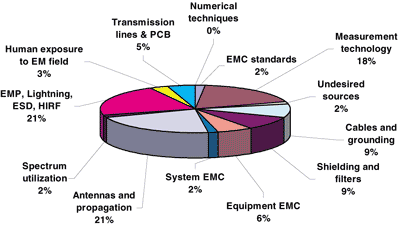 |
TOPIC STATISTICS IN 1999 |
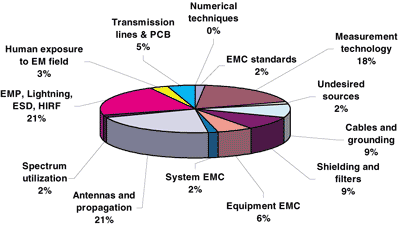 |
TOPIC STATISTICS IN 2000 |
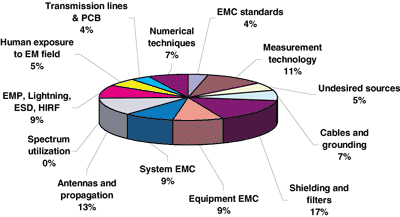 |
Figure 1. Topic statistics of papers published in
the Transactions on EMC in
|
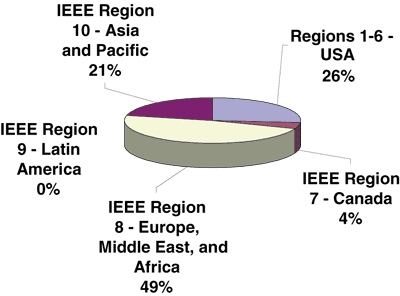
Figure 2. Worldwide distribution of papers published in the
Transactions on EMC in the years 1998, 1999, and 2000.
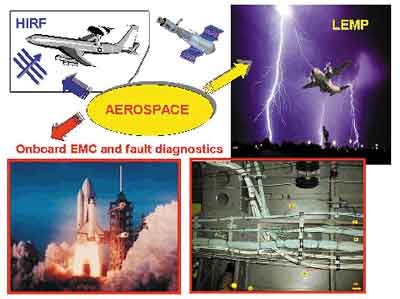
Figure 3. The EMC environment in aerospace.
Figure 4 – The elements on which the development of the
Transactions on
EMC should be founded.
Figure 5. Revision time of papers accepted for publication in the
Transactions
on EMC in 2000.
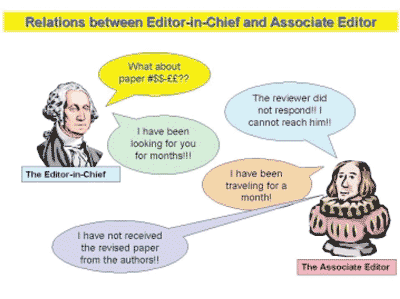 |
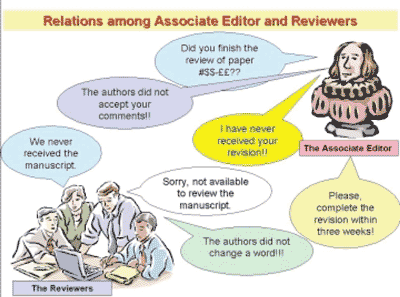 |
Figure 6 – Representation of the difficulties
encountered
|
